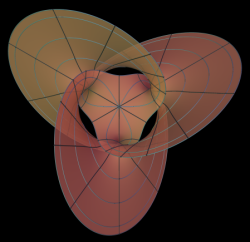projective plane

The projective plane is the surface you would get if you glued the
edge of a disk to the edge of a Möbius
band. This sounds easy to do, since a disk and a Möbius band each
have one edge. But the process becomes hopelessly tangled and is, in fact,
impossible. The projective plane needs a fourth
dimension, in addition to the three we live in, to be fully realized.
The idea of the projective plane arose from the study of perspective by
mathematicians and painters in the Renaissance. In trying to represent parallel
lines in space on the two dimensional surface of a painting, it was found
useful to introduce the notion of a line at infinity on which parallel lines met. The study of the geometry that adds this extra
line of ideal points to the ordinary familiar plane came to be known as projective geometry, because of its
use in studying projections of figures onto different lines. This idea was
even more important in three dimensions, since projections are used for
representing three dimensional figures on planes.
An interesting property of the projective plane is that any "straight" line
on it, followed far enough, comes back to the starting point. (The old arcade
version of the game of Asteroids was played on a virtual projective plane:
the screen was a disk, and when an asteroid went off one edge of the screen
it emerged on the opposite side.) The projective plane is also non-orientable,
as a result of which any two dimensional object pushed along a path back
to its starting point would be reversed.


